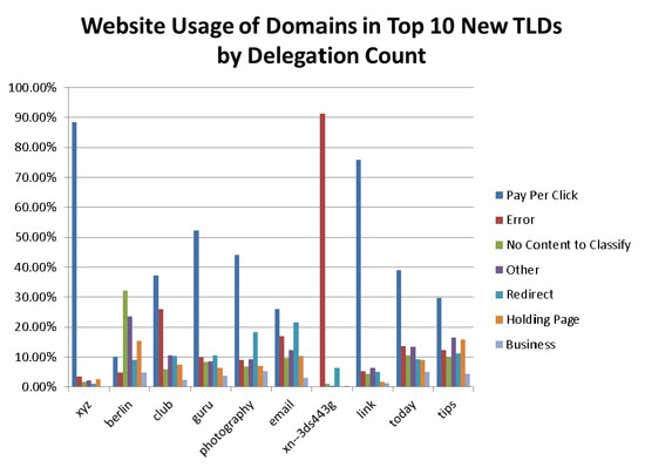It’s been half a year since the web’s first new top-level domains (gTLDs) went live, a moment Quartz called “the biggest land rush in history.” The web is in the process of moving from fewer than two dozen TLDs (such as the .com in qz.com) to over a thousand. Nearly 200 have already gone live.
Now that the dust has settled, it is possible to look back over the past few months and see what effect these new TLDs are really having on the web. Verisign, the company that administers .com and .net, looked at the domains that have been registered on the new TLDs—which include .singles, .democrat, and .global, among others—to see what they’re really being used for. Here’s what they found:

Verisign suggests that the high proportion of pay-per-click websites (such as this or this) is a combination of two things. The first is speculation, or people buying up domains on the basis that the names will become valuable at some point. In the meanwhile, they fill them with ads. The second is that people buy new domains and don’t know what to do with them.
Verisign also looked more closely at the top ten new TLDs. The odd-looking domain in the chart below is Chinese: .在线. The spike in errors, says Verisign, is because the Chinese government bought up some 10,000 domains, which are apparently inaccessible to American visitors. (Verisign is based in the US.)

Verisign worries the new domains may eat into its .com business. (From a recent press release: “Think .com is dead? Think again.”) So it is understandable that the company is keen to stress the shortcomings of the new TLDs.
Still, the pay-per-click characterisation seems unfair, since it is the registrars (ie the company from whom people buy domain names) that fill them with ads until the owner does something with it. It may be better to wait for people to activate their websites before passing judgment. Websites such glasgow.rocks, used the Glasgow Rocks basketball team, or getdata.ninja, are good examples of creativity.
Moreover, Verisign may have the wrong idea about what the internet is actually for. A “key finding” from its study is that only 3% of domain names registered on new TLDs are for business websites, compared to 30% for established TLDs. That is to suggest that the internet’s primary use is for business. It is a narrow view of the world, and of the web. The internet remains superlative at allowing people to waste time and have a bit of fun. New domains are unlikely to change that.



